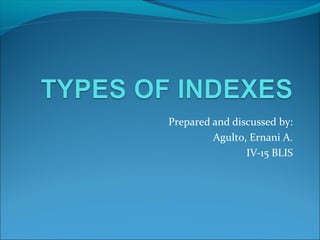
Types of indexes
- 1. Prepared and discussed by: Agulto, Ernani A. IV-15 BLIS
- 2. INDEXES Can be categorized many ways; By arrangement or by searching structure or by specific subject fields or by purpose. Can be a mix of different types of indexes. e.g. alphabetical and author.
- 3. FORMS of INDEX By arrangement, (E.g. alphabetical, classified…) By the types of materials index, (E.g. book, periodical, newspaper index…) By physical form. (E.g. card, microform, computerized index)
- 4. ALPHABETICAL INDEXES Is the most common method. More convenient and follows familiar order. Based on orderly principle of letters of the alphabet. All entries are in one alphabetical order, including subject terms, author names and place names.
- 5. ALPHABETICAL INDEXES MAJOR DRAWBACKS: problems of synonym and scattering of entries. Scattering- Subjects are not drawn together under generic term E.g. When looking for the information on janitor fish, do we look for janitor fish or fish?
- 6. AUTHOR INDEXES Not the most common type of indexes, but not a rarity. Are those whose entry points are people, organizations, corporate authors, etc… Users are guided to titles of documents by the way of authors. Authors can also be used as an indirect subject approach.
- 7. AUTHOR INDEXES Authors are strong indicators of subject content (Cleveland, 1976) e.g. Freud, Sigmund- Psychology or psychoanalysis.
- 8. BOOK INDEXES Most people (reading public) think of. Are lists of words, generally alphabetical, at the back of the book, giving the page location of the subject or name associated with each word. Pinpoints the information to the user. ISSUE: not every book (e.g reference book) has a quality index, if not, none at all.
- 9. CITATION INDEXES Consists of a list of articles, with a sublist under each article of subsequently published papers that cite the articles. Shows who cited the paper. This kind of index implies that a cited paper has an internal subject relationship with the papers that cited it, and use this relationship to cluster related documents– citations reflect document content.
- 10. CITATION INDEXES PRIMARY ADVANTAGE: leads the user to the latest articles.
- 11. CLASSIFIED INDEXES has its contents arranged systematically by classes or subject headings. Have an important role to play (especially in scientific indexing, e.g. biology). But general indexes that are classified mystify the general users, they do not understand how they are constructed. Indexes SHOULD BE user-oriented.
- 12. COORDINATE INDEXES allow terms to be combined or coordinated. The idea of punching or notching a card and then using a mechanical device, such as long needles, to drop out cards containing the combination of index terms of interest. The basis of modern retrieval systems, world wide web search tools.
- 13. COORDINATE INDEXES Is really a process; coordinating produces an index. e.g. individual index terms Pecan and Trees are combined, we have a new class of things: Pecan trees.
- 14. CUMULATIVE INDEXES is a combination or merging of a set of indexes over time. Indexes for established works can often cover many decades. Generally, apply to journals and to large, important works and are published as separate volumes. Are complex and usually done by teams of indexers.
- 15. FACETED INDEXES Facet, by definition, means one side of something that has many sides. In a faceted indexing system, any subject is not a single unit but has many aspects; A facet index attempts to discover all the individual aspects of a subject and then synthesis them in a way that best describes the subject under discussion.
- 16. FACETED INDEXES A faceted scheme is a type of synthetic classification, Often called an analytic-synthetic system. PHILOSOPHICAL BASIS: an author looks at a subject in a different way or brings out new ideas or a new discovery.
- 17. FACETED INDEXES With a faceted system, we put together the class most closely representing the informational concepts in the new document.
